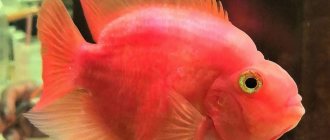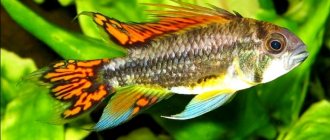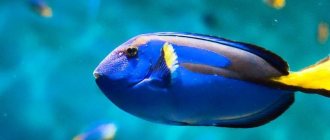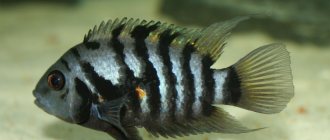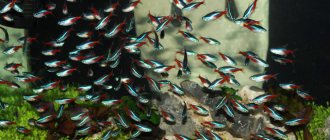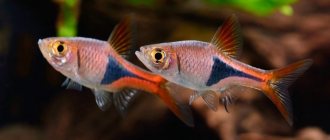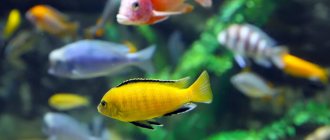Gastromyzon punctulatus Inger & Chin, 1961.
Names are synonymous (regardless of type)
Russian: Guitar fish, Butterfly loach, Pseudoscat
Etymology
Gastromyzon: From the Greek gaster, meaning "stomach" and myzo, meaning "to suck" - "sucking on the stomach." punctulatus: from Latin punctulate "small dotted", in reference to a pattern of dots on the body.
Order: Cyprinidae Family: Gastromyzontidae Genus: Gastromyzon
Habitat
Southeast Asia.
Endemic to the island of Borneo, found in Brunei Darussalam, Indonesia, and Malaysia.
They live in headwaters of rivers and mountain streams/streams, usually in fast-moving water over rocky substrate. Often found above or below cascades and waterfalls, with clear, cool, oxygenated water.
The bottom consists of gravel, rocks, boulders or bedrock with a rich biofilm formed by algae and other microorganisms.
Aquatic plants are rare, while riparian vegetation may be present.
Causes of diseases
The main cause of most diseases comes down one way or another to the conditions of detention. Insufficient flow, low oxygen levels, a lot of organic waste, cloudy water with inappropriate pH and dGH values, poor quality food - all of these, individually or in combination, can most likely lead to health problems in fish. As a rule, various bacterial infections or infections with microorganisms are secondary, as a result of weakened immunity due to improper living conditions. You can put an equal sign between the favorable habitat of Gastromizons and their health.
Description
Strongly flattened body shape. The paired fins are very large and semicircular in shape. The rounded head is also flattened, its line flowing gently into the pectoral fins, which are adjacent to the smaller ventral fins. The body tapers at the tail. The lower paired fins and abdomen have suction cups that allow them to hold on even in very strong currents.
In some individuals living in nature, the fins are so developed that they allow them to climb up waterfalls. There are no scales on the belly and head; internal organs are even visible there. The mouth is lower and directed upward; there are also no horn scrapers.
The color of the body is variable - from light brown to completely black, it changes depending on the condition of the fish. When stressed and frightened, the color turns pale, the spots are almost indistinguishable, and during the period of aggression the overall color also becomes lighter, but a dark stripe appears along the back, as well as along the edge of the fins.
In normal condition, the fins are folded, but if they are raised along with the tail spread out, this is a manifestation of aggression.
Size:
Grows up to 6.5 cm.
Content
- 1 Description
- 2 Conditions of detention
- 3 Behavior
- 4 Food
Source: www.interaquaristik.de
Source: www.aquaportail.com
Source: i33.servimg.com
- Other names: Gastromyzon punctulatus, Guitar fish.
- Origin: Borneo.
- Size: up to 6 cm.
- Temperature: 22-25 °C.
- Water parameters: pH 6-7.5, dKH 8-15.
- Lighting: moderate.
- Behavior: gregarious, peaceful, active at night.
- Content difficulty: medium.
Behavior and Compatibility
Small and calm benthic freshwater fish, completely peaceful, compatible with non-aggressive and non-territorial species that are suited to currents and do not need high temperatures. For large predators who are not used to defending themselves, they will become easy prey.
Prefers the company of relatives of 4-5 individuals, which contributes to more natural behavior. They will establish a hierarchy, fighting in safe, colorful battles. They have the ability to significantly change their color. It can vary from dark black to cream during skirmishes. If you place soil/stones of different shades in the aquarium, you will be able to observe the color change in accordance with the surface.
Although this fish has a sucker, it is not a “cleaner” of algae in the aquarium; rather, it only eats biofilm.
Due to the lack of scales on the abdomen and head, it is very sensitive to chemicals and medications, so if it is necessary to treat other fish, it is better to remove healthy gastromyzons for a while.
Reproduction
Sexual dimorphism in gastromyzons is pronounced:
- Females are larger and more plump than males.
- The color of males is brighter and more colorful, and their body structure is more graceful.
Unfortunately, despite the efforts of aquarists and experts, it was not possible to achieve reproduction of pseudorays in aquarium conditions. Fish reproduce only in the natural conditions of the wild, and scientists have not yet been able to study the features of this process. All representatives supplied to pet stores are caught from natural rivers and streams.
Gastromizon is a calm, unpretentious miniature fish that has won the hearts of aquarists with its attractive appearance and peaceful disposition. Despite the sensitivity of fish to the composition of water, if you follow simple recommendations, you can observe the interesting behavior of pets in the aquarium for a long time.
Aquarium
For a small group you will need an aquarium of 60 liters or more. It is not so much the size that is important, but the area of the bottom. If there is not enough space, intraspecific conflicts are possible.
When decorating, use a soil consisting of sand or fine gravel, add some pebbles of different sizes and it is important to provide the landscape with large flat stones on which the fish will hang, you can use driftwood.
In their natural environment, they live in rushing streams and near waterfalls. It has a suction cup that allows it to hang tightly among all those swirls. Therefore, it is best to recreate similar conditions in an aquarium; to do this, it is enough to create a moderate current. Powerful filtration will ensure good oxygenation and good mixing of the water. Direct the flow rather towards the lower part of the aquarium.
It moves along the bottom in jerks, from one surface to another, while trying to avoid the ground. This is explained by the fact that fish have very delicate and sensitive abdominal skin. Mainly spends time on stones, from which it collects plaque along the way. Plants are also used for movement, so species with hard leaves are suitable, for example Echinodorus, Ferns, Crinum, Anubias.
A tight fitting lid is essential as they can literally ride up the glass.
Water parameters:
Temperature: 23 - 25° C pH: 6.0 - 7.5 Hardness: 5 - 15° dH
Adapts without problems over a wide range of pH and dH. It is worth paying attention to the temperature of your aquarium; these fish are very sensitive to too warm water. Additionally, temperatures above 28°C can kill it. If they become abnormally pale, they are suffering from the heat!
They need active aeration, good filtration, weekly replacement of a third of the water and cleaning of the soil.
They are intolerant of the accumulation of organic waste - it is necessary to control the content of nitrites in the water, to which these fish are very sensitive. Should not be added to biologically immature aquariums and adapts most easily to stable, biologically mature aquariums.
Conditions of detention
The main thing when keeping Gastromizon punctulatus is the purity and quality of the water. They do not tolerate being in cloudy, stagnant water, so you will have to provide the aquarium with filtration and aeration, as well as change 30% of the water weekly. It is highly desirable to create an artificial powerful current. The water itself should be from 23 to 25 ° C (although they feel tolerable at 18 ° C), have a neutral or slightly acidic pH and a hardness of 8-15 °. It is recommended to fill the bottom with a sufficient number of large stones, broad-leaved plants or other objects with a smooth surface, since this species spends most of its time stuck to the stones.
Nutrition
The basis of nutrition should be plant foods. They eat unicellular algae that form on glass, decorations and plants. All types of food are accepted, but the most suitable are sinking tablets for bottom fish and flakes with a high content of herbal additives. For variety, you can feed frozen small bloodworms, tubifex, cyclops and brine shrimp. They won’t refuse cucumber, spinach or zucchini.
A weekly fasting day is necessary; systematic overeating is fraught with obesity.
Popular types of Gastromyzons
Butterfly Loach
Beaufortia or Butterfly Loach, scientific name Beaufortia kweichowensis, belongs to the family Balitoridae (River Loaches)
Gastromizon viriosus
Gastromyzon viriosus, scientific name Gastromyzon viriosus, belongs to the family Balitoridae
Gastromyzon cornusacus
Gastromyzon cornusaccus, scientific name Gastromyzon cornusaccus, belongs to the family Balitoridae (River Loaches)
Gastromyzon ctenocephalus
Gastromyzon ctenocephalus, scientific name Gastromyzon ctenocephalus, belongs to the family Balitoridae (River loaches)
Gastromizon lepidogaster
Gastromyzon lepidogaster, scientific name Gastromyzon lepidogaster, belongs to the family Balitoridae (River Loaches)
Gastromizon Monticola
Gastromyzon Monticola, scientific name Gastromyzon monticola, belongs to the family Balitoridae (River Loaches)
Gastromyzon ocellatus
Gastromyzon ocellatus, scientific name Gastromyzon ocellatus, belongs to the family Balitoridae (River Loaches)
Gastromyzon scytulus
Gastromyzon scitulus, scientific name Gastromyzon scitulus, belongs to the family Balitoridae (River Loaches)
Gastromyzon stellatus
Gastromyzon stellatus, scientific name Gastromyzon stellatus, belongs to the family Balitoridae (River Loaches)
Gastromizon farragus
Gastromyzon farragus, scientific name Gastromyzon farragus, belongs to the family Balitoridae (River Loaches)
Gastromizon zebra
Gastromyzon zebra, scientific name Gastromyzon zebrinus, belongs to the family Balitoridae
Sevelia lined
Sewellia lineolata, scientific name Sewellia lineolata, belongs to the family Balitoridae (Balitoridae)
Gastromizon of the Nan River
Gastromizon of the Nan River, scientific name Hemimyzon nanensis, belongs to the family Balitoridae (Balitoridae).
They are not an easy species to keep and are not recommended for beginner aquarists. Distributed mainly in the professional environment of commercial aquariums.
Diseases of pseudorays
How long do pseudorays live? Their life expectancy reaches 8 years, in some cases - 5. However, their life expectancy can be significantly reduced if they are provided with improper care or the wrong chemistry is used.
Pseudorays do not have scales, so they are prone to various diseases and are sensitive to changes in water parameters and to chemistry, which should be taken into account when treating false rays. Also, if the treatment must take place in a community aquarium, healthy fish should be placed in another tank for this period.
This type of fish has been little studied, so it is extremely difficult to talk about the diseases to which fish are susceptible.
Breeding
It is not possible to breed gastromyzons at home. They reproduce naturally and are then caught for further keeping in the aquarium. The mechanism of reproduction has not yet been fully studied.
Gastromizons are excellent fish for aquarium keeping, which can be kept by a novice aquarist. Buy young specimens from a pet store: they will adapt better and live longer. Unpretentious pseudo-rays will clean the aquarium of green algae; they get along well with other peace-loving fish.
How to determine gender
Sexual differences in befortia are not expressed in any way, so it is extremely difficult to determine their gender. There is an opinion that males are larger than females.
Determining the sex of Sevilles is a little easier: males have brighter colors than females, they are smaller and slimmer.
to distinguish females from males in gastromyzons : males are characterized by their large size.
